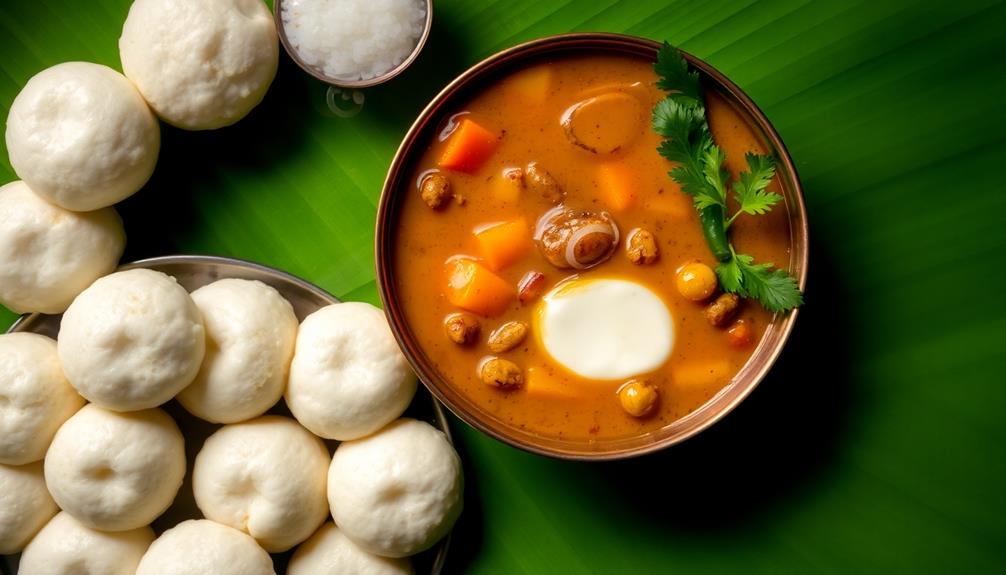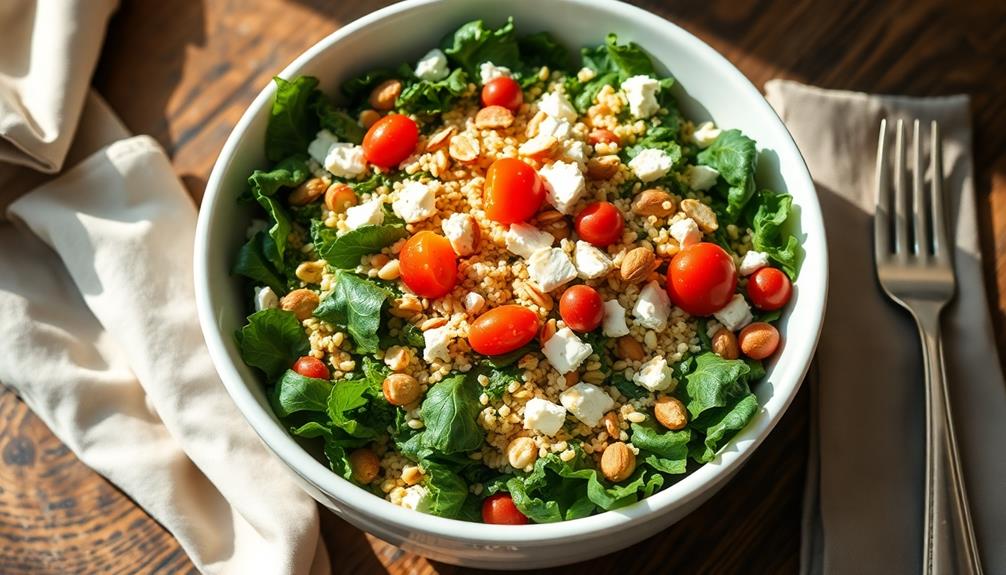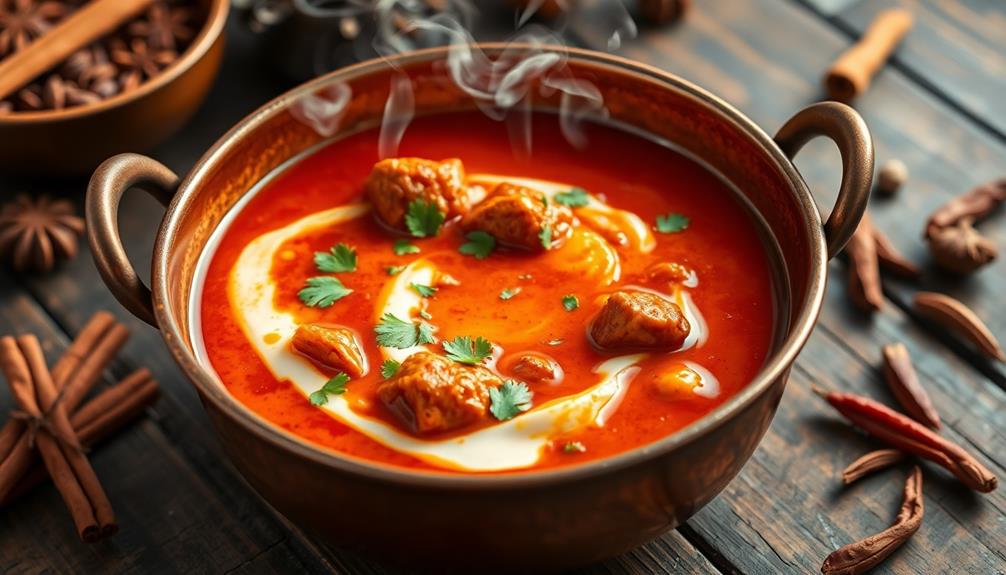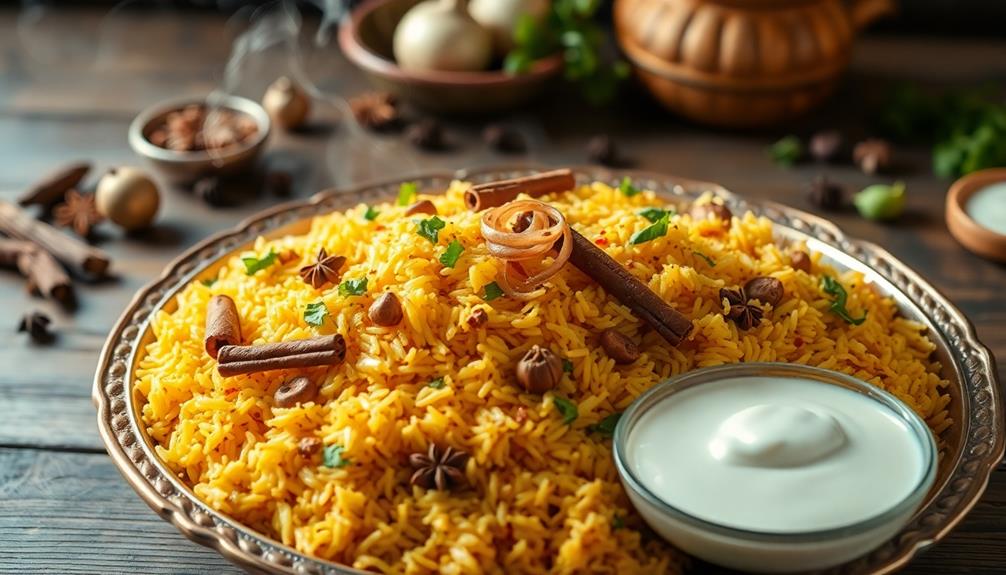You'll love idli sambar, a delicious South Indian dish that combines fluffy steamed rice cakes with a flavorful lentil-based soup. It's a beloved breakfast or light meal option, packed with nutrients and comforting flavors. To make idlis, you'll soak rice and lentils, grind them into a batter, and let it ferment before steaming. The sambar is a tasty mix of vegetables, lentils, and spices simmered to perfection. This vegetarian-friendly meal is not only satisfying but also easy to customize with your favorite veggies. Get ready to explore the rich history and cultural significance behind this classic dish as you embark on your culinary journey.
Key Takeaways
- Idli Sambar is a popular South Indian dish combining steamed rice cakes (idlis) with a lentil-based vegetable soup (sambar).
- The dish is known for its nutritional balance, offering carbohydrates from idlis and proteins from sambar's lentils and vegetables.
- Idli batter requires fermentation for 8-12 hours, while sambar involves cooking lentils with vegetables and aromatic spices.
- Idli Sambar is often served as breakfast or a light meal, and is culturally significant in South Indian cuisine.
- The dish is vegetarian-friendly, customizable with various vegetables, and can be accompanied by chutneys for added flavor.
History
The origin story of idli sambar is steeped in culinary tradition. You'll find that this beloved South Indian dish has roots that stretch back centuries. Idli, those soft and fluffy rice cakes, have been around since ancient times. They've been mentioned in old texts from as far back as the 6th century!
But what about sambar, you ask? Well, it's got its own fascinating history. Legend has it that sambar was created in the 17th century in the kitchen of Shahuji I, the Maratha ruler of Thanjavur. The story goes that his cook accidentally added tamarind to a lentil soup, creating this tangy and flavorful dish.
Now, you might wonder how these two delicious items came together. It's believed that the pairing of idli and sambar became popular in the 20th century. As people looked for hearty, nutritious meals, they found that idli and sambar were a perfect match.
The combination provides a balanced meal with carbohydrates, proteins, and vegetables all in one tasty package. Today, you'll find idli sambar enjoyed across India and beyond!
Recipe
Idli Sambar is a beloved South Indian dish that combines soft, steamed rice cakes (idli) with a flavorful lentil-based vegetable soup (sambar). This classic combination isn't only delicious but also nutritious, making it a popular choice for breakfast or as a light meal throughout the day.
To prepare this dish, you'll need to make both the idli batter and the sambar separately. The idli batter requires fermentation, so it's best to start this process a day in advance. The sambar can be prepared while the idlis are steaming, allowing you to serve both components hot and fresh.
Ingredients for Idli:
- 2 cups parboiled rice
- 1 cup urad dal (black gram)
- 1/2 teaspoon fenugreek seeds
- Water for soaking
- Salt to taste
Ingredients for Sambar:
- 1 cup toor dal (pigeon peas)
- 2 cups mixed vegetables (carrots, beans, pumpkin, etc.)
- 1 onion, chopped
- 2 tomatoes, chopped
- 1 tablespoon sambar powder
- 1 teaspoon turmeric powder
- Tamarind pulp (size of a small lemon)
- Salt to taste
- 2 tablespoons oil
- 1 teaspoon mustard seeds
- 1 sprig curry leaves
- 2-3 dried red chilies
To prepare the idli, soak the rice, urad dal, and fenugreek seeds separately for 4-6 hours. Grind them into a smooth batter, mix well, and let it ferment overnight.
For the sambar, cook the toor dal and vegetables until soft. In a separate pan, sauté onions, add tomatoes, sambar powder, turmeric, and tamarind pulp. Combine this with the cooked dal and vegetables. Prepare a tempering with mustard seeds, curry leaves, and dried red chilies, and add it to the sambar.
Steam the idli batter in greased molds for 10-12 minutes. Serve hot idlis with the flavorful sambar.
For best results, use a mixture of parboiled and regular rice for the idli batter to achieve the perfect texture. The fermentation process is crucial for soft, fluffy idlis, so allow enough time for this step.
When making sambar, adjust the consistency by adding water as needed, and feel free to customize the vegetable mix according to your preferences. Leftover idli batter can be refrigerated for 2-3 days, while sambar can be stored for up to a week when refrigerated properly.
Cooking Steps
Let's walk through the cooking steps for delicious idli sambar!
You'll start by soaking rice and lentils overnight, then grinding them into a smooth batter.
After fermenting the batter until it's doubled in size, you'll steam the idlis in special molds and prepare a flavorful sambar side dish to complete your meal.
Step 1. Soak Rice and Lentils Overnight
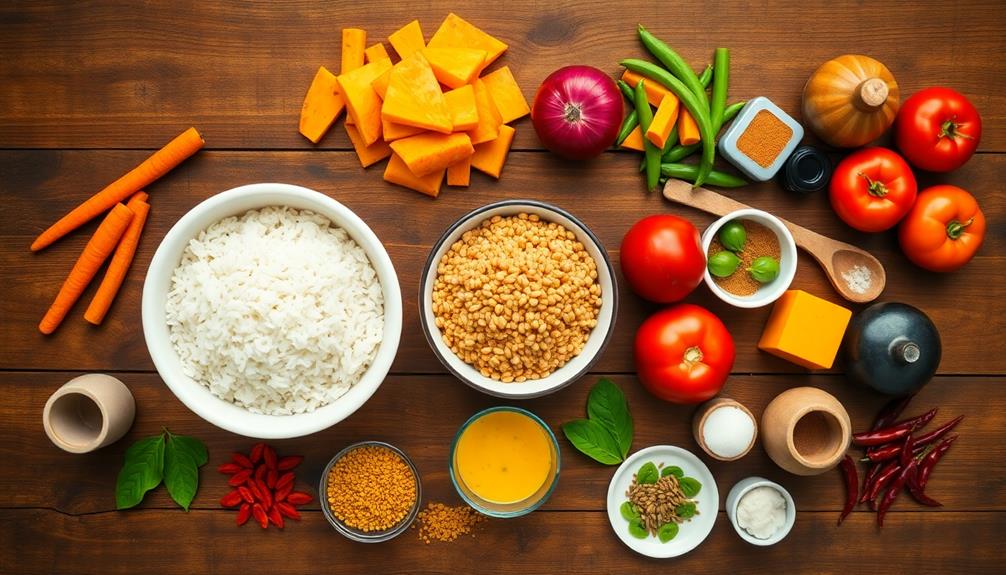
Soaking rice and lentils overnight is a crucial first step in preparing authentic idli sambar. You'll want to start this process the evening before you plan to cook.
First, gather your ingredients: you'll need 2 cups of idli rice and 1 cup of urad dal (black gram lentils). Rinse both the rice and lentils separately under cold water until the water runs clear. This helps remove any dust or impurities.
Next, place the rice in a large bowl and cover it with about 3 inches of water. In another bowl, do the same with the urad dal. You can add a teaspoon of fenugreek seeds to the dal for extra flavor and health benefits. Make sure there's enough water, as the rice and lentils will absorb quite a bit overnight.
Leave the bowls in a cool, dry place for 6-8 hours or overnight. In the morning, you'll notice the rice and dal have swollen and softened. They're now ready to be ground into a smooth batter for your idlis.
This soaking process is essential for achieving the perfect texture and taste in your final dish.
Step 2. Grind Soaked Ingredients Into Batter
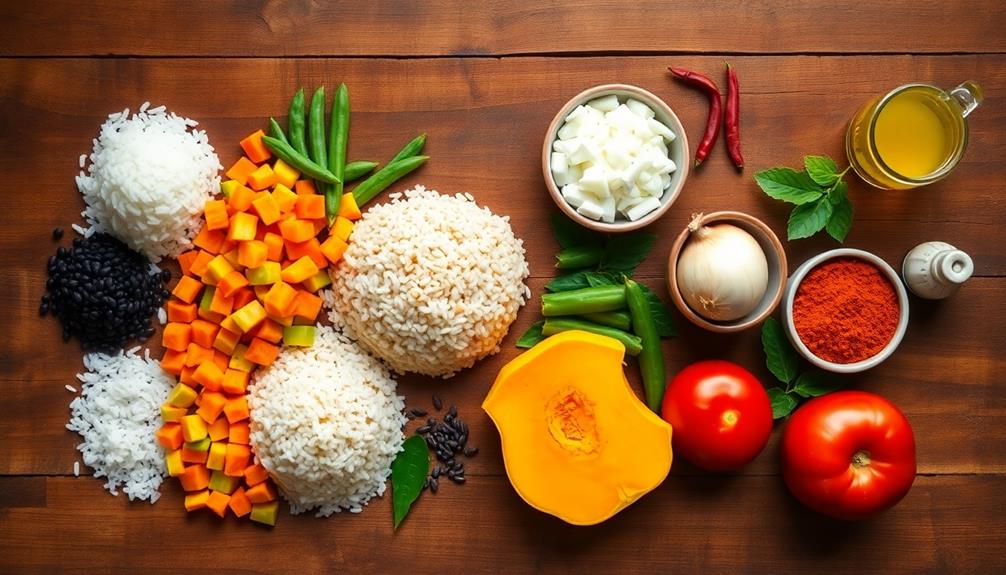
After soaking overnight, the next crucial step is grinding the softened rice and lentils into a smooth batter. You'll need a wet grinder or a powerful blender for this task.
Start by draining the soaked ingredients and giving them a quick rinse. Then, add the rice and lentils to your grinding machine in batches. It's important not to overload it!
As you grind, you'll need to add a little water to help create a smooth consistency. Don't add too much, though – you want a thick batter, not a watery one.
Keep grinding until the mixture is silky smooth with no grainy texture. This might take about 20-30 minutes, so be patient!
Once you've ground all the ingredients, transfer the batter to a large bowl. Now's the time to add a pinch of salt and mix it well.
Cover the bowl with a clean cloth and let it rest in a warm place for 8-12 hours. This fermentation process is key to getting those fluffy, spongy idlis you're aiming for.
Your batter's now ready for the next exciting step!
Step 3. Ferment Batter Until Doubled

Fermentation is the magic behind light and fluffy idlis. Once you've ground your batter, it's time to let nature do its work. Pour the smooth mixture into a large, clean bowl, making sure there's enough room for it to expand. Cover the bowl with a clean cloth or lid, but don't seal it too tightly – the batter needs to breathe!
Now, find a warm spot in your kitchen for the batter to rest. If it's chilly, you can place the bowl in your oven with just the light on. The ideal temperature is around 80-85°F (27-29°C). Let the batter sit undisturbed for 8-12 hours, or overnight.
During this time, friendly bacteria will work their wonders, creating tiny air pockets that'll make your idlis soft and spongy. You'll know the fermentation is complete when the batter has doubled in volume and smells slightly sour. If you see small bubbles on the surface, that's a great sign!
Give the batter a gentle stir to deflate it slightly. Now you're ready to steam your idlis and enjoy the fruits of your patience!
Step 4. Steam Idlis in Molds

With your perfectly fermented batter ready, it's time to transform it into steaming hot idlis. Grab your idli molds and give them a light coating of oil to prevent sticking. Don't forget to grease the sides too!
Now, carefully spoon the batter into each mold, filling them about three-quarters full. This gives the idlis room to expand as they cook.
Next, set up your steamer with water in the bottom and bring it to a boil. Once it's steaming, place the filled idli molds inside. Cover the steamer and let the idlis cook for about 10-12 minutes. You'll know they're done when they're firm to the touch and a toothpick comes out clean.
When the idlis are ready, turn off the heat and let them cool for a minute or two. Using a spoon, gently remove each idli from its mold. They should come out easily if you greased the molds well.
Arrange your freshly steamed idlis on a plate, and they're ready to serve! Enjoy them hot with your favorite sambar and chutney for a delicious, traditional South Indian meal.
Step 5. Prepare Sambar Side Dish
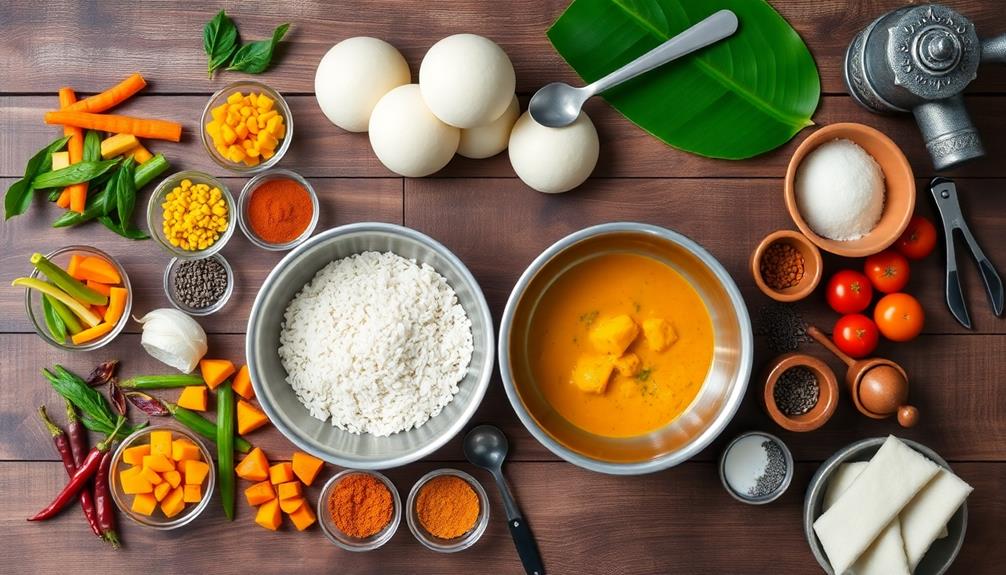
Now that your idlis are steaming, it's time to prepare the flavorful sambar that'll complement them perfectly.
Start by heating some oil in a pan and add mustard seeds, letting them pop and sizzle. Toss in curry leaves, chopped onions, and tomatoes, stirring until they're soft and fragrant.
Next, you'll add your favorite vegetables like carrots, beans, and pumpkin. Pour in some water and let everything simmer until the veggies are tender.
It's time for the star ingredient – toor dal! Add pre-cooked toor dal to the mix, along with turmeric, red chili powder, and salt to taste.
Let the sambar bubble away, soaking up all those delicious flavors.
While it's cooking, you can make a quick tempering by frying some more mustard seeds, curry leaves, and dried red chilies in ghee. Pour this sizzling mixture over your sambar for an extra burst of flavor.
Final Thoughts
The beloved combination of idli and sambar represents more than just a delicious meal. It's a celebration of South Indian cuisine that brings comfort and joy to many.
As you've learned, making idli and sambar from scratch can be a rewarding experience. You'll appreciate the flavors even more when you've put in the effort to create this dish yourself.
Remember, practice makes perfect! Don't be discouraged if your first attempt isn't restaurant-quality. Each time you make idli sambar, you'll improve your technique and timing.
Experiment with different spices and ingredients to find your perfect balance of flavors. You can also try adding various side dishes or chutneys to complement your meal.
Sharing this dish with friends and family is a great way to introduce them to South Indian cuisine. It's a fantastic option for breakfast, lunch, or dinner, and it's suitable for vegetarians and vegans alike.
Frequently Asked Questions
Can Idli Sambar Be Made Gluten-Free?
Yes, you can make idli sambar gluten-free. It's naturally free from gluten as it's typically made with rice and lentils. Just ensure you're using gluten-free ingredients for any additional seasonings or spices you add to the dish.
How Long Can Leftover Idli Sambar Be Stored in the Refrigerator?
You can store leftover sambar in the fridge for 3-4 days. Keep it in an airtight container to maintain freshness. For best quality, reheat only what you'll eat. Don't leave it at room temperature for long.
What Are Some Common Variations of Idli Sambar Across Different Regions?
You'll find various regional twists on this dish. In Karnataka, you might enjoy a spicier version, while Tamil Nadu's is often thicker. Maharashtra adds coconut, and Andhra Pradesh's sambar tends to be tangier and more fiery.
Is Idli Sambar Suitable for Vegans?
You'll be happy to know that idli sambar is typically vegan-friendly. It's made with plant-based ingredients like lentils, vegetables, and rice. However, always double-check, as some variations might include ghee or other dairy products.
Can Idli Sambar Be Frozen for Later Consumption?
You can freeze idli sambar for later consumption. It's best to freeze them separately. When you're ready to eat, thaw and reheat the sambar gently. The idlis may lose some texture but will still be edible.
